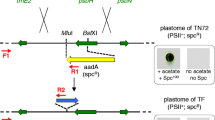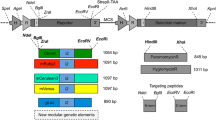Abstract
The unicellular green alga Chlamydomonas reinhardtii has been identified as a promising organism for the production of recombinant proteins. While during the last years important improvements have been developed for the production of proteins within the chloroplast, the expression levels of transgenes from the nuclear genome were too low to be of biotechnological importance. In this study, we integrated endogenous intronic sequences into the expression cassette to enhance the expression of transgenes in the nucleus. The insertion of one or more copies of intron sequences from the Chlamydomonas RBCS2 gene resulted in increased expression levels of a Renilla-luciferase gene used as a reporter. Although any of the three RBCS2 introns alone had a positive effect on expression, their integration in their physiological number and order created an over-proportional stimulating effect observed in all transformants. The secretion of the luciferase protein into the medium was achieved by using the export sequence of the Chlamydomonas ARS2 gene in a cell wall deficient strain and Renilla-luciferase could be successfully concentrated with the help of attached C-terminal protein tags. Similarly, a codon adapted gene variant for human erythropoietin (crEpo) was expressed as a protein of commercial relevance. Extracellular erythropoietin produced in Chlamydomonas showed a molecular mass of 33 kDa probably resulting from post-translational modifications. Both, the increased expression levels of transgenes by integration of introns and the isolation of recombinant proteins from the culture medium are important steps towards an extended biotechnological use of this alga.






Similar content being viewed by others
References
Bentley DL (2005) Rules of engagement: co-transcriptional recruitment of pre-mRNA processing factors. Curr Opin Cell Biol 17:251–256
Berthold P, Schmitt R, Mages W (2002) An engineered Streptomyces hygroscopicus aph 7′′ gene mediates dominant resistance against hygromycin B in Chlamydomonas reinhardtii. Protist 153:401–412
Bollig K, Lamshoft M, Schweimer K, Marner FJ, Budzikiewicz H, Waffenschmidt S (2007) Structural analysis of linear hydroxyproline-bound O-glycans of Chlamydomonas reinhardtii—conservation of the inner core in Chlamydomonas and land plants. Carbohydr Res 342:2557–2566
Chapman BS, Thayer RM, Vincent KA, Haigwood NL (1991) Effect of intron A from human cytomegalovirus (Towne) immediate-early gene on heterologous expression in mammalian cells. Nucleic Acids Res 19:3979–3986
Cheetham JC, Smith DM, Aoki KH, Stevenson JL, Hoeffel TJ, Syed RS, Egrie J, Harvey TS (1998) NMR structure of human erythropoietin and a comparison with its receptor bound conformation. Nat Struct Biol 5:861–866
Cheon BY, Kim HJ, Oh KH, Bahn SC, Ahn JH, Choi JW, Ok SH, Bae JM, Shin JS (2004) Overexpression of human erythropoietin (EPO) affects plant morphologies: retarded vegetative growth in tobacco and male sterility in tobacco and Arabidopsis. Transgenic Res 13:541–549
Davies JP, Weeks DP, Grossman AR (1992) Expression of the arylsulfatase gene from the beta 2-tubulin promoter in Chlamydomonas reinhardtii. Nucleic Acids Res 20:2959–2965
de Hostos EL, Togasaki RK, Grossman A (1988) Purification and biosynthesis of a derepressible periplasmic arylsulfatase from Chlamydomonas reinhardtii. J Cell Biol 106:29–37
de Hostos EL, Schilling J, Grossman AR (1989) Structure and expression of the gene encoding the periplasmic arylsulfatase of Chlamydomonas reinhardtii. Mol Gen Genet 218:229–239
Fischer N, Rochaix JD (2001) The flanking regions of PsaD drive efficient gene expression in the nucleus of the green alga Chlamydomonas reinhardtii. Mol Genet Genomics 265:888–894
Franklin SE, Mayfield SP (2004) Prospects for molecular farming in the green alga Chlamydomonas. Curr Opin Plant Biol 7:159–165
Franklin SE, Mayfield SP (2005) Recent developments in the production of human therapeutic proteins in eukaryotic algae. Expert Opin Biol Ther 5:225–235
Fuhrmann M (2004) Production of antigens in Chlamydomonas reinhardtii: green microalgae as a novel source of recombinant proteins. Methods Mol Med 94:191–195
Fuhrmann M, Oertel W, Hegemann P (1999) A synthetic gene coding for the green fluorescent protein (GFP) is a versatile reporter in Chlamydomonas reinhardtii. Plant J 19:353–361
Fuhrmann M, Hausherr A, Ferbitz L, Schodl T, Heitzer M, Hegemann P (2004) Monitoring dynamic expression of nuclear genes in Chlamydomonas reinhardtii by using a synthetic luciferase reporter gene. Plant Mol Biol 55:869–881
Fuhrmann M, Oertel W, Berthold P, Hegemann P (2005) Removal of mismatched bases from synthetic genes by enzymatic mismatch cleavage. Nucleic Acids Res 33:e58
Goldschmidt-Clermont M, Rahire M (1986) Sequence, evolution and differential expression of the two genes encoding variant small subunits of ribulose bisphosphate carboxylase/oxygenase in Chlamydomonas reinhardtii. J Mol Biol 191:421–432
Griesbeck C, Kobl I, Heitzer M (2006) Chlamydomonas reinhardtii: a protein expression system for pharmaceutical and biotechnological proteins. Mol Biotechnol 34:213–223
Gruber H, Kirzinger SH, Schmitt R (1996) Expression of the Volvox gene encoding nitrate reductase: mutation-dependent activation of cryptic splice sites and intron-enhanced gene expression from a cDNA. Plant Mol Biol 31:1–12
Harris EH (1989) The Chlamydomonas sourcebook: a comprehensive guide to biology and laboratory use. Academic Press, San Diego
Heifetz PB (2000) Genetic engineering of the chloroplast. Biochimie 82:655–666
Heitzer M, Zschoernig B (2007) Construction of modular tandem expression vectors for the green alga Chlamydomonas reinhardtii using the Cre/lox-system. Biotechniques 43:324, 326, 328 (passim)
Jacobs K, Shoemaker C, Rudersdorf R, Neill SD, Kaufman RJ, Mufson A, Seehra J, Jones SS, Hewick R, Fritsch EF et al (1985) Isolation and characterization of genomic and cDNA clones of human erythropoietin. Nature 313:806–810
Janknecht R, de Martynoff G, Lou J, Hipskind RA, Nordheim A, Stunnenberg HG (1991) Rapid and efficient purification of native histidine-tagged protein expressed by recombinant vaccinia virus. Proc Natl Acad Sci USA 88:8972–8976
Jelkmann W (1992) Erythropoietin: structure, control of production, and function. Physiol Rev 72:449–489
Kindle KL (1990) High-frequency nuclear transformation of Chlamydomonas reinhardtii. Proc Natl Acad Sci USA 87:1228–1232
Kovar JL, Zhang J, Funke RP, Weeks DP (2002) Molecular analysis of the acetolactate synthase gene of Chlamydomonas reinhardtii and development of a genetically engineered gene as a dominant selectable marker for genetic transformation. Plant J 29:109–117
Koziel MG, Carozzi NB, Desai N (1996) Optimizing expression of transgenes with an emphasis on post-transcriptional events. Plant Mol Biol 32:393–405
Lareau LF, Green RE, Bhatnagar RS, Brenner SE (2004) The evolving roles of alternative splicing. Curr Opin Struct Biol 14:273–282
Leon-Banares R, Gonzalez-Ballester D, Galvan A, Fernandez E (2004) Transgenic microalgae as green cell-factories. Trends Biotechnol 22:45–52
Liu M, Grigoriev A (2004) Protein domains correlate strongly with exons in multiple eukaryotic genomes—evidence of exon shuffling? Trends Genet 20:399–403
Liu K, Sandgren EP, Palmiter RD, Stein A (1995) Rat growth hormone gene introns stimulate nucleosome alignment in vitro and in transgenic mice. Proc Natl Acad Sci USA 92:7724–7728
Lumbreras V, Stevens DR, Purton S (1998) Efficient foreign gene expression in Chlamydomonas reinhardtii mediated by an endogenous intron. Plant J 14:441–447
Matsumoto S, Ikura K, Ueda M, Sasaki R (1995) Characterization of a human glycoprotein (erythropoietin) produced in cultured tobacco cells. Plant Mol Biol 27:1163–1172
Mattick JS (1994) Introns: evolution and function. Curr Opin Genet Dev 4:823–831
Mayfield SP, Franklin SE (2005) Expression of human antibodies in eukaryotic micro-algae. Vaccine 23:1828–1832
Mayfield SP, Franklin SE, Lerner RA (2003) Expression and assembly of a fully active antibody in algae. Proc Natl Acad Sci USA 100:438–442
Mayfield SP, Manuell AL, Chen S, Wu J, Tran M, Siefker D, Muto M, Marin-Navarro J (2007) Chlamydomonas reinhardtii chloroplasts as protein factories. Curr Opin Biotechnol 18:126–133
Melis A (2007) Photosynthetic H2 metabolism in Chlamydomonas reinhardtii (unicellular green algae). Planta 226:1075–1086
Palmiter RD, Sandgren EP, Avarbock MR, Allen DD, Brinster RL (1991) Heterologous introns can enhance expression of transgenes in mice. Proc Natl Acad Sci USA 88:478–482
Rochaix JD (2002) The three genomes of Chlamydomonas. Photosynth Res 73:285–293
Saint-Jore-Dupas C, Faye L, Gomord V (2007) From planta to pharma with glycosylation in the toolbox. Trends Biotechnol 25:317–323
Sayre RT, Wagner RE, Siripornadulsil S, Farias C (2001) Transgenic algae for delivering antigens to an animal. US patent number 7,410,637
Schroda M (2006) RNA silencing in Chlamydomonas: mechanisms and tools. Curr Genet 49:69–84
Schroda M, Beck CF, Vallon O (2002) Sequence elements within an HSP70 promoter counteract transcriptional transgene silencing in Chlamydomonas. Plant J 31:445–455
Voss S, Skerra A (1997) Mutagenesis of a flexible loop in streptavidin leads to higher affinity for the Strep-tag II peptide and improved performance in recombinant protein purification. Protein Eng 10:975–982
Walter C, Steinau T, Gerbsch N, Buchholz R (2003) Monoseptic cultivation of phototrophic microorganisms–development and scale-up of a photobioreactor system with thermal sterilization. Biomol Eng 20:261–271
Wessel D, Flugge UI (1984) A method for the quantitative recovery of protein in dilute solution in the presence of detergents and lipids. Anal Biochem 138:141–143
Acknowledgments
We wish to thank Regina Groebner-Fererra for perfect technical assistance and Amparo Hausherr for the purification of luciferase from E. coli. This work has been financially supported in parts by the Bavarian Ministry of Economic Affairs, Infrastructure, Transport and Technology, the Bavarian Ministry of Environment, Public Health and Consumer Protection and the German Federal Ministry of Education and Research including an ExistSeed grant and a BioChance grant together with the Entelechon GmbH.
Author information
Authors and Affiliations
Corresponding author
Electronic supplementary material
Below is the link to the electronic supplementary material.
Rights and permissions
About this article
Cite this article
Eichler-Stahlberg, A., Weisheit, W., Ruecker, O. et al. Strategies to facilitate transgene expression in Chlamydomonas reinhardtii . Planta 229, 873–883 (2009). https://doi.org/10.1007/s00425-008-0879-x
Received:
Accepted:
Published:
Issue Date:
DOI: https://doi.org/10.1007/s00425-008-0879-x




